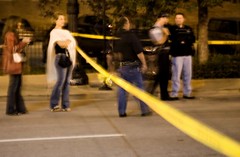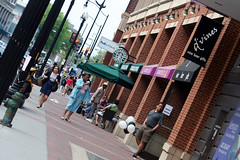“If you don’t have safe streets, all the light rail lines in the world aren’t going to save your city”

Posted November 30, 2009 at 1:31PM
The environmental community needs to broaden our definition of what is "environmental." First, my friend and frequent collaborator Lee Epstein posted a thoughtful blog entry on urban education and its effect on middle class families' housing choices and, thus, on suburban sprawl. This week, I've had several occasions to think about that other elephant in the smart-growth room: personal safety.
 To slow the spread of development willy-nilly across the landscape, we need to repopulate our central cities, many of which lost population in the latter half of the 20th century. We're starting to make some real progress on that but, to grow that progress and make it stick, we need to get serious about crime.
To slow the spread of development willy-nilly across the landscape, we need to repopulate our central cities, many of which lost population in the latter half of the 20th century. We're starting to make some real progress on that but, to grow that progress and make it stick, we need to get serious about crime.
That was certainly one of the strongest messages to emerge from the residents of Indianapolis's Smart Growth Redevelopment District. They know better than anyone whether their community is safe enough to flourish. And then on Friday I ran across a thoughtful but troubling blog post from Indianapolis resident and Urbanophile Aaron Renn, about all sorts of things, but concluding with some notes about a shooting in a revitalized section of his city (not the redevelopment district I visited):
"This week in Indy a horrific shooting left Gabe Jordan, wine steward at upscale specialty grocery Goose the Market, in critical condition and likely paralyzed from the waist down. This was an apparently random act of violence. He was shot in the back during a robbery while he was out walking his dog late one evening near his home on the East Side . . .
"Urbanist blogs don't often talk a lot about crime or education or race. I have talked the race issue but am a rarity. Those conversations tend to happen in more specialty places. But things like this remind us that things like safety and education and social justice are the basics.
If you don't have safe streets, all the light rail lines in the world aren't going to save your city . . .
"I've walked all over the East Side. I've walked around Fountain Square and other places at night by myself frequently and nothing has happened to me. The odds of anything like this happening to anyone are probably very low. But the plain fact is it would be nearly non-existent in a place like suburban Fishers."
Renn's commentary on the subject is more extended than I have quoted here, and I invite you to read and consider it.
Here in DC, there was a recent, tragic murder of a 9-year-old child in his own home, in our city's trendiest success story of revitalization, Columbia Heights.  As Petula Dvorak wrote in Friday's Washington Post, "Oscar Fuentes was killed there by a gunshot through the front door of his apartment. He was looking through the peephole at the commotion outside. Someone had tried to rob his family members as they walked home along Columbia Road, and the women ducked inside to get away." This is almost unbelievably heartbreaking to read, yet Dvorak's main point is that the other kids in the neighborhood don't consider it all that unusual.
As Petula Dvorak wrote in Friday's Washington Post, "Oscar Fuentes was killed there by a gunshot through the front door of his apartment. He was looking through the peephole at the commotion outside. Someone had tried to rob his family members as they walked home along Columbia Road, and the women ducked inside to get away." This is almost unbelievably heartbreaking to read, yet Dvorak's main point is that the other kids in the neighborhood don't consider it all that unusual.
Dvorak continues:
"It went from a neighborhood that had small ethnic groceries, check cashing joints and little else to a teeming commercial district that looks straight out of an urban planner's handbook.
"There is public art, a pop-jet fountain, a restaurant that serves wasabi-crusted meatloaf. Some residents are taking an online poll to determine whether their new plaza should be adorned with a Christmas tree this year.
"And in that city block where the boy died are the District's most prominent Latino community organizations, a church, tenant-owned buildings, two well-regarded charter schools, a wonderful youth center, a health center, counselors, social workers, a mural with the planet Earth that reads 'He's got the whole world in his hands' and a display of Chinese brush paintings by kids."
These are our showcase neighborhoods. Yeah, I know and applaud the statistics showing that city crime has gone down a lot since the worst days of the 1970s and 1980s, while suburban crime has gone up. And I know the statistics about how personal risk from car accidents in the suburbs make them just as unsafe as the city, in their way. But I also know that most of the people who cite those stats are bold, creative-class types who love urban living anyway.
Renn is right when he says that this sort of random gunfire is much less common in newer suburbs (and he's a city-lover, too). This is a real problem, and we wish it away at our peril.
 So, what to do? I don't pretend to know, really. But maybe we start by being honest about the problems that linger in our cities rather than sweeping them under the rug while we celebrate the virtues of urban bikesharing, streetcars, and green roofs.
So, what to do? I don't pretend to know, really. But maybe we start by being honest about the problems that linger in our cities rather than sweeping them under the rug while we celebrate the virtues of urban bikesharing, streetcars, and green roofs.
Rummaging around on the topic, I was pleased to learn that the Local Initiatives Support Corporation (LISC), whose track record on inclusive, affordable urban smart growth is impressive (and with whom NRDC is beginning to partner on revitalization), has a Community Safety Initiative that "has helped establish police/community partnerships in over a dozen cities nationwide." Other LISC projects specifically target parcels where crime is taking place for renovation and adaptive reuse.
Working with the MetLife Corporation, LISC also administers an award program to communities that do especially outstanding work in addressing problems of crime and violence. One of this year's award recipients, announced earlier this month, is Brooklyn's Myrtle Avenue Revitalization Project:
"Once tagged "Murder Avenue" by the broader Brooklyn community, Myrtle Avenue struggled with a negative image stemming from high crime and perceptions that it was unsafe due to building vacancies and poorly maintained public space. Simple yet effective strategies were used by MARP and the NYPD to turn the tides.
"MARP began by facilitating communication between merchants and the 88th precinct and by removing all graffiti from the commercial corridor. From there, the partners worked to increase police visibility on Myrtle Avenue, helping to reduce crime and make the retail district a more welcoming place to visit.
Other ongoing efforts include storefront and streetscape improvements, recruiting new entrepreneurs to fill retail vacancies and attract foot traffic, hosting special events, and coordinating a system for Myrtle Avenue merchants to communicate quickly and frequently to facilitate crime prevention. The commercial corridor now thrives as reductions in crime and vacancies continue to attract new businesses and private investment to the area."
The neighborhood's restoration appears to be progressing very nicely. You can read about it here.
Among other strategies, addressing vacant properties (not much of an issue in Columbia Heights or Fountain Square, perhaps, but a significant one in the Indianapolis Smart Growth Redevelopment District and elsewhere) may help. Writing last week on Smart Growth America's blog, Mara D'Angelou cites research finding an increase in total assaults in a given set of blocks by 18.5% for every additional vacancy. And the design of redevelopment can help, too: Seattle has a good summary of "crime prevention through environmental design" that explains how natural, passive surveillance of an area ("eyes on the street") can be enhanced with lighting (not glaring "crime lights"), window placement, porches and balconies, landscaping, and right-size fencing, among other things. (Wikipedia also has a good summary.)
It's a beginning.
Reposted from November 23.

